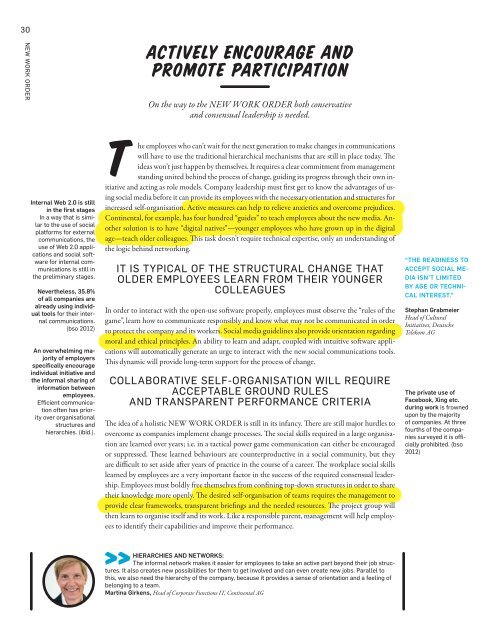New Work Order - Orgatec
New Work Order - Orgatec
New Work Order - Orgatec
- No tags were found...
You also want an ePaper? Increase the reach of your titles
YUMPU automatically turns print PDFs into web optimized ePapers that Google loves.
30<strong>New</strong> <strong>Work</strong> orderInternal Web 2.0 is stillin the first stagesIn a way that is similarto the use of socialplatforms for externalcommunications, theuse of Web 2.0 applicationsand social softwarefor internal communicationsis still inthe preliminary stages.Nevertheless, 35.8%of all companies arealready using individualtools for their internalcommunications.(bso 2012)An overwhelming majorityof employersspecifically encourageindividual initiative andthe informal sharing ofinformation betweenemployees.Efficient communicationoften has priorityover organisationalstructures andhierarchies. (ibid.).Actively encourage andpromote participationOn the way to the <strong>New</strong> <strong>Work</strong> <strong>Order</strong> both conservativeand consensual leadership is needed.The employees who can’t wait for the next generation to make changes in communicationswill have to use the traditional hierarchical mechanisms that are still in place today. Theideas won’t just happen by themselves. It requires a clear commitment from managementstanding united behind the process of change, guiding its progress through their own initiativeand acting as role models. Company leadership must first get to know the advantages of usingsocial media before it can provide its employees with the necessary orientation and structures forincreased self-organisation. Active measures can help to relieve anxieties and overcome prejudices.Continental, for example, has four hundred “guides” to teach employees about the new media. Anothersolution is to have “digital natives”—younger employees who have grown up in the digitalage—teach older colleagues. This task doesn’t require technical expertise, only an understanding ofthe logic behind networking.It is typical of the structural change thatolder employees learn from their youngercolleaguesIn order to interact with the open-use software properly, employees must observe the “rules of thegame”, learn how to communicate responsibly and know what may not be communicated in orderto protect the company and its workers. Social media guidelines also provide orientation regardingmoral and ethical principles. An ability to learn and adapt, coupled with intuitive software applicationswill automatically generate an urge to interact with the new social communications tools.This dynamic will provide long-term support for the process of change.Collaborative self-organisation will requireacceptable ground rulesand transparent performance criteriaThe idea of a holistic <strong>New</strong> <strong>Work</strong> <strong>Order</strong> is still in its infancy. There are still major hurdles toovercome as companies implement change processes. The social skills required in a large organisationare learned over years; i.e. in a tactical power game communication can either be encouragedor suppressed. These learned behaviours are counterproductive in a social community, but theyare difficult to set aside after years of practice in the course of a career. The workplace social skillslearned by employees are a very important factor in the success of the required consensual leadership.Employees must boldly free themselves from confining top-down structures in order to sharetheir knowledge more openly. The desired self-organisation of teams requires the management toprovide clear frameworks, transparent briefings and the needed resources. The project group willthen learn to organise itself and its work. Like a responsible parent, management will help employeesto identify their capabilities and improve their performance.“The readiness toaccept social mediaisn’t limitedby age or technicalinterest.”Stephan GrabmeierHead of CulturalInitiatives, DeutscheTelekom AGThe private use ofFacebook, Xing etc.during work is frownedupon by the majorityof companies. At threefourths of the companiessurveyed it is officiallyprohibited. (bso2012)Hierarchies and networks:The informal network makes it easier for employees to take an active part beyond their job structures.It also creates new possibilities for them to get involved and can even create new jobs. Parallel tothis, we also need the hierarchy of the company, because it provides a sense of orientation and a feeling ofbelonging to a team.Martina Girkens, Head of Corporate Functions IT, Continental AG
















